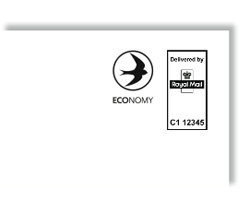
What exactly is being “Delivered by Royal Mail”?
Marketing expert Peter Frings argues that Royal Mail is not looking at the big picture in requiring its “Delivered by” brand on direct mail. Royal Mail has announced that downstream access mail will carry a new ‘Delivered by Royal Mail’ postmark, to replace the ‘S block’ that is currently printed in the top right hand corner of a DSA-delivered envelope. The change comes into effect in June, but there is a grace period until the end of December 2012.
The Royal Mail decision document at first glance seems non-controversial enough – indeed, Decision Marketing did a vox pop piece last year when the proposal was first mooted, and a couple of creative directors pronounced that it was a ‘storm in a tea cup’. But actually it’s another depressing example of the inability of Royal Mail management to focus on the bigger picture – rebuilding the long-term health of the postal sector.
Royal Mail was forced to delay its initial proposals last year after protests, and go through the exercise of a ‘consultation’ with the downstream access industry.
Why is it persisting with this seemingly cosmetic exercise at a time when it is facing the biggest crisis in its existence? Royal Mail’s core mail collection and delivery unit – picking up the post, sorting it and putting it through a letterbox – has lost nearly £1bn in four years. And mail volumes have fallen by a quarter since 2006, to 62m letters and parcels a day (in 2010/11).

A mock-up of the new Royal Mail “Delivered by” mark
The consultation document from Royal Mail was honest about the rationale:
“An initiative designed to give recognition to the dedication of Royal Mail’s postmen and postwomen who do a fantastic job in delivering mail… Our postmen and women often ask why we don’t put our mark on the post that we deliver to the receiving customer to show that Royal Mail had been responsible for delivering it. Hence our initiative was in response to our people to show that we have listened to them.”
What happened was that Moya Greene, (the new CEO) was visiting the Glasgow Mail Centre, and was being harangued by Glaswegian posties who have been sold the line that the problems with the postal industry are all down to ‘unfair’ competition from those nasty downstream access providers.
Moya Greene made an off-the-cuff commitment to respond, and it’s become a matter of ‘face’ for her internally to deliver on her promise.
But if there is a morale problem with Royal Mail staff, it stems from historical management practices and trade union relations. A gesture to Royal Mail staff, which comes entirely at the expense of other providers in the postal market, does not address the underlying issue.
I’m sure Royal Mail staff make hundreds of suggestions each year that are not implemented – if Royal Mail wants to show its staff that it listens to them, there must be many other opportunities. I suspect that most of them would require much more management effort by Royal Mail, than getting DSA providers to print a different indicium on the envelope.
Memo to Royal Mail management – start thinking about the big picture!
Of course, if Royal Mail’s management were serious about reversing the decline of their business, one starting point would be honesty about the causes of the decline – the arrival of new digital channels, poor staff relations, an antediluvian union, lack of investment and incompetent management over decades, and a massive pension timebomb – rather than endlessly peddling the line about competitors being allowed to ‘cherrypick’ the more profitable areas of their business.
The facts are that 99% of mail is still delivered over the final mile by Royal Mail, (see Ofcom’s report from March this year) and that Royal Mail gets between 95% and 93% of the income a customer pays for downstream access mail. (I’ve just looked at the last £10m Brightsource spent on downstream access for our clients over recent months… 94% of that sum went to Royal Mail, only 6% to our upstream carriers, TNT and UK Mail.)
And if Royal Mail were interested in the long-term health of the postal industry, they would have paid more attention to one of the points that Brightsource submitted as part of the consultation process. Namely that anything which distracts the consumer from the overall marketing message, will reduce response and ROI, and make other channels more attractive.
Having two indicia on the envelope (one from the DSA provider, and one saying ‘Delivered by Royal Mail’), sets up a contradiction in the recipient’s mind. It is like there is an argument going on in front of the customer – here’s a logo saying the envelope was delivered by Royal Mail, here’s another logo saying it is from Brightpost, TNT, or UK Mail.
Your ISP probably delivers its broadband services to your house over a wire managed by a telecommunications company’s wholesale arm – but that telecom company doesn’t insist on its logo popping up every time you log on to the internet.
We also shouldn’t underestimate the impact in the minds of senior marketers when considering direct mail as one potential channel, compared to others. Direct mail will become tainted by the perception that it is a squabble between Royal Mail and its direct access partners, and clients will be less inclined to be associated with it.
Given the competition from new channels, now is the time for the postal industry to be co-operating to present a united picture of a professional and effective marketing channel.
What Royal Mail should have done
Marketing mail works best with as little visual distraction from an indicium as possible. We should have just one indicium to identify who is managing the delivery of the mail pack, plus a small Royal Mail licence number – so that Royal Mail knows which provider the mail has come from.
This would meet the reasonable business objectives of downstream access operators, Royal Mail and the regulators:
- Least possible interference with the marketing message, thus supporting the long-term viability of mail as a marketing channel
- Clear identification of the carrier/licence number, through the inclusion of a C1 number
Royal Mail’s response to this suggestion?
“Access mail has been operating with two separate elements to the Access Indicium since 2004 without any such complaint of this nature from consumers.”

Peter Frings founded UK-based marketing services and technology company Brightsource in 2002 as managing director, and now has almost 30 years’ experience in marketing services. Brightsource is part of global marketing company Cello and has offices in Cheltenham, London, Edinburgh and Beijing.












